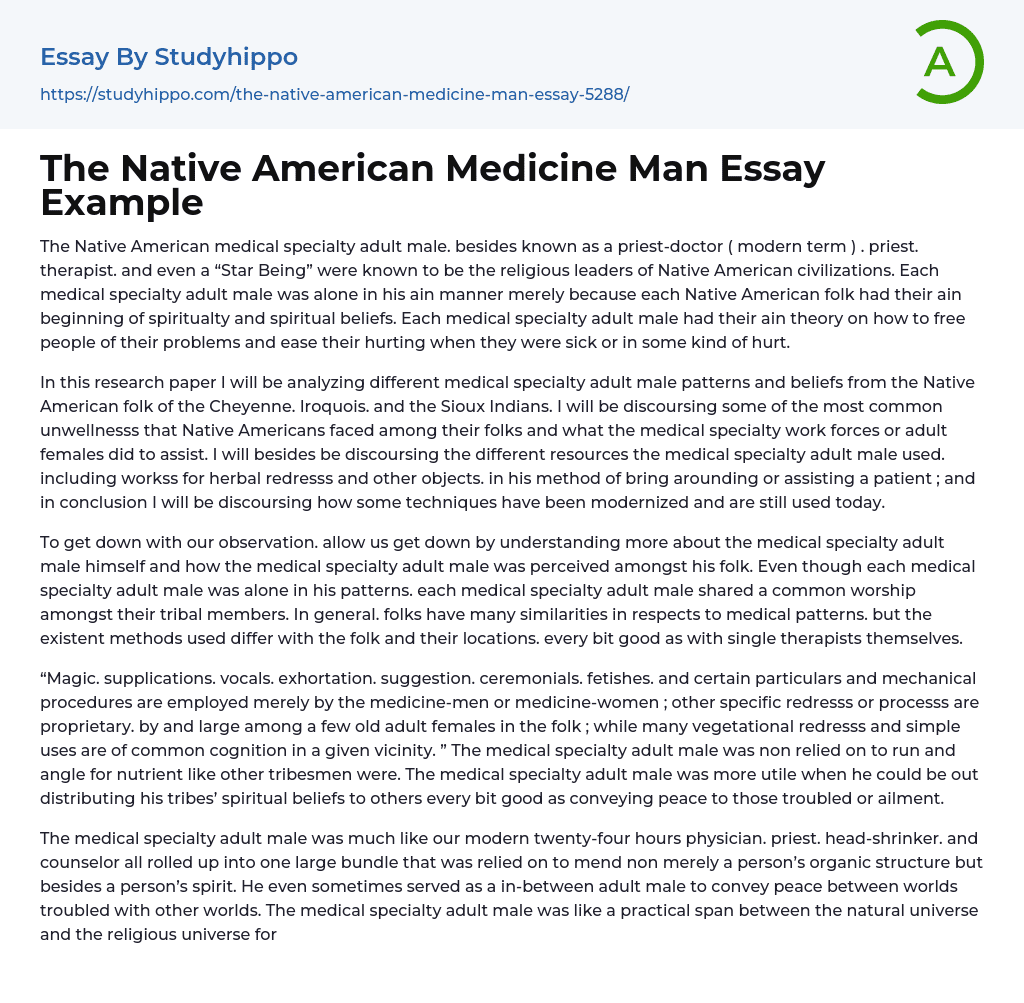This research paper examines the practices and beliefs of Native American medical specialists, also referred to as priest-doctors, priests, therapists, and "Star Beings." These specialists were the religious leaders of their individual tribes. Each specialist had a unique healing approach based on their tribe's spirituality and beliefs. The focus will be on the Cheyenne, Iroquois, and Sioux tribes. Common illnesses faced by Native Americans will be discussed along with how these specialists treated them using remedies specific to their respective tribes. The resources utilized in their healing methods included herbal remedies and other objects. Additionally, the modernization of some techniques used by these medical specialists that are still employed today will be examined. It is important to note that while each specialist had unique practices, they all shared a common worship among tribal members. However, there were diffe
...rences in medical patterns depending on different tribes and locations as well as individual therapists. Medicine-men or medicine-women combined magic, supplications, vocals, exhortation suggestion ceremonials fetishes ,and specific mechanical procedures in their treatments. Knowledge of community-specific remedies and procedures was possessed by only a select few elderly women while herbal remedies and simple treatments were widely known among the local population.The medicine man played a dual role within the tribe, functioning as both a healer and spiritual guide to bring peace to those who were unwell or troubled. Essentially, he performed multiple duties as a doctor, priest, therapist, and counselor. People relied on him for physical and spiritual healing alike. Moreover, he served as a mediator in resolving conflicts within the community. He acted as a practical link between the natural world and the spiritual realm for th
betterment of his community's well-being.
Various methods such as magical practices, prayers vocal rituals, and ceremonies were utilized in medical practices and beliefs. Magic was frequently employed to counteract negative influences from deceased spirits or mythical beings. Prayers sought assistance from benevolent spirits when tending to patients' needs. Healing rituals involved singing prayers or exhortations while creating loud noises with the aim of warding off evil spirits believed to be responsible for illness.
Ceremonies that combined these techniques were often intricate and costly, as seen among the Navaho Indians. These ceremonies incorporated special objects like molded rocks, lightning-riven wood, feathers, claws, hair, figurines of mythical creatures,and representations of the sun and lightning.It was thought that these objects possessed an enigmatic power capable of preventing disease or countering its effectsCertain communities followed dietary restrictions and abstained from specific foods as a form of treatment. The Cheyenne Indians, originally living near the Cheyenne River, were forced to settle in a subdivision of the Red River of the North by the Sioux Indians in the late 18th century. Medicine men played a significant role in their society, serving as doctors, priests, and therapists for both physical and spiritual well-being. These medicine men possessed knowledge about medicinal plants and rituals, chants, and songs with magical powers. Instead of using U.S. currency for payment or trade activities with others, they accepted trade items. The spiritual beliefs and traditions strongly adhered to by the Cheyenne people influenced how medicine men assisted those in need. The text also discusses the beliefs and practices of both the Cheyenne and Iroquois Indians regarding spirit beings and healing techniques. The Cheyenne believe in spirit beings connected to
Ma’heo’o, an associated divine entity linked to physical life and spiritual existence. Ceremonial works depict symbolic representations or elements portraying animate beings related to these spirit beings. Some Cheyenne view ecological crises as an end to Hestanov caused by natural and supernatural factors.Healing techniques employed by the Iroquois Indians encompass a range of methods such as herb tea, root remedies, ritual purification, sweat lodges, smoke, supplication, and occasional surgery. Both men and women fulfill the role of therapists with the aim of restoring patients both biologically and spiritually. These healing practices were conducted by six tribes - Mohawk Indians, Seneca, Oneida, Cayuga, Onondaga, and Tuscarora - who formed a united alliance in what is now New York. Similar to the Cheyenne people's belief system regarding spirit-beings' presence among them; the Iroquois also believed that plagues and diseases originated from evil spirits. To combat these illnesses caused by malevolent spirits; they would hold spiritual festivals seeking assistance from their great spirit in purging their people of these harmful entities. Furthermore , it was believed that failing to fulfill dreams or desires could result in contracting diseases. According to their beliefs, dreams held significant importance as powerful experiences capable of unveiling the cause of illness and contributing to healing efforts. The Iroquois perceived dreams as a means to transcend time and space by connecting with ancestors or spiritual guides while uncovering one's soul desires for a more enriching existence. Additionally , dreams were viewed as a way to restore lost energy and heal emotional pain within their healing rituals which involved employing wooden masks believed to establish connections with spirits and the dream world.

